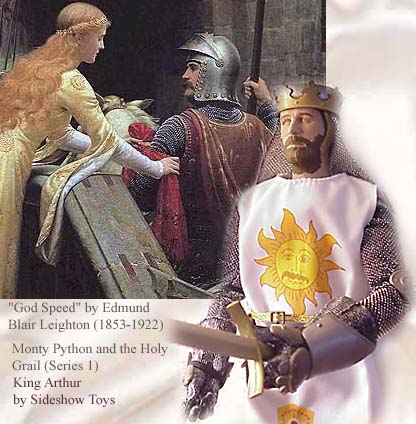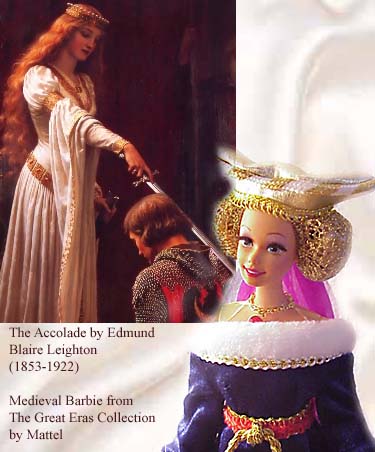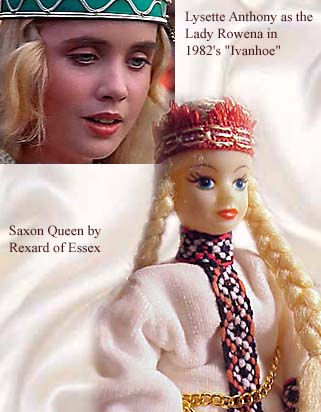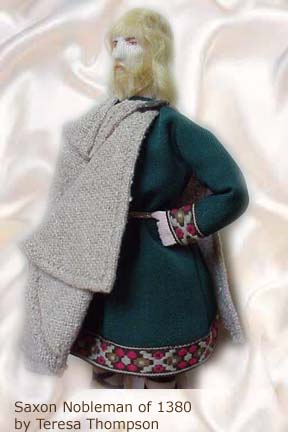
|
The English Court by Mary Harrsch |
By far the most popular figures of the English Court appear to be members of the house of Tudor. I have found so many different versions of Henry VIII, his various wives, and his daughter, Elizabeth I, that I had to devote entire pages to them. But they are centuries beyond the beginnings of a formal English court.
The Arthurian Legend - "...thy name and glory cling to all high places like a golden cloud." - Idylls of the King, Lord Tennyson. The origin and historicity of King Arthur have been the subjects of scholarly debates for centuries. A number of scholars suggest he was an early Romano-Briton leader and may have been a descendant of one Lucius Artorius Castus. Castus was an historical 2nd century Dalmatian general stationed in Britain who commanded the Roman auxiliary troops, known as Sarmations, on an expedition to crush an uprising in Armorica. This theory was most recently embraced by P.J.F. Turner. 
Ancient Welsh historian, Nennius, relates, "Arthur fought...together with the Kings of the British; but he was Dux Bellorum." Brittania.com explains: "This would seem to confirm the popular view today that Arthur was a professional soldier: a brilliant military leader employed in an official capacity by an alliance of British Kings to carry out their warfare against all coming enemies. "Dux Bellorum" translates literally as Duke of Battles. This might be comparable to the Roman "Dux Britannorum" in charge of the Northern British defences. Though many think the Roman "Comes Britanniarum" a better fit, for he led mobile cavalry forces across the country, as perhaps indicated by Arthur's supposed widespread battles."
Regardless of the true origin of Arthur, he has been a popular subject for doll producers although he is typically portrayed in a costume of the period of the Crusades rather than the late Roman period five hundred years earlier. Peggy Nisbet has produced figures of King Arthur, Sir Lancelot, and Queen Guinevere but they have, so far, commanded a rather healthy price on Ebay, often topping $75 each. Instead, I opted for a nicely detailed 12-inch "action figure" of Monty Python's Arthur from Sideshow Toys. (As I mentioned on my introductory page, I have learned that figures marketed to males are usually called "action figures"). His chain mail is fashioned from a metallic cloth that looks more proportionate than the chain mail crafted of actual metal rings made for figures produced by Elite Brigade.
Medieval Barbie from the Mattel Great Eras collection currently serves as Arthur's consort although her attire is more appropriate to the 12th century than the 5th or 6th. Her "bliaut" is made of velveteen trimmed with fur. These long overgowns were worn by both sexes from 11th to late 13th centuries. The woman's version fitted closely at the bust and had long loose sleeves. It was worn with a belt. Originally a Persian Coat made of light, filmy material, the fashion was probably introduced to England and France by returning Crusaders. The garment was eventually modified and fashioned of warmer fabrics like velvet and lined with fur. It was then renamed the pelice or pelicon. Lydie LaBarthe explains, "Fragments of twill and cotton velvet have been found dating back to 9th century France. The textile known as pile on pile or double velvet is also one of the oldest known velvet weaving techniques. Corduroy, (Fr: Corde du Roi) was woven for minor nobility and the servants of kings in the middle ages. It has extra wefts that form lengthwise rows of floats that are cut to form a pile, resembling the corrugated effect of the corduroy we know today. It was also related to fustian, and was often made of sturdy wool, linen or cotton, from the early centuries AD. "
Her headdress also reflects the styles of the 12th century with its padded headpiece atop hair neatly restrained by gold netting.
Mattel made a Limited Edition Ken as King Arthur and Barbie as Guinevere but I've been outbid for it several times. Mego, a toy company that produced 8" figures from 1971 - 1983 also produced Arthur as well as Lancelot, Galahad, and the Black Knight. I hope to add them to my collection as well. British Artist, Teresa Thompson, offers a beautifully detailed 8" hand-crafted doll of Arthur and Guinevere in her "Legend" series. I wish more companies would consider the 8" size since they don't take up as much display space as the larger sizes. Anastasia produces a porcelain Guinevere that is over 22" tall and sells for about $26. Her costume is nicely detailed but I'm running low on display space.
As the power of the Roman Empire faded, British warlords established small unstable kingdoms. By the mid-5th century, these warlords revived the Roman policy of hiring Germanic mercenaries known as Saxons to help defend them against warlike peoples of the north (Picts and Scots). The Saxon mercenaries revolted against their British chiefs and began the process of invasion and settlement that destroyed the native ruling class and established Germanic kingdoms throughout the island by the 7th century.
"449 In this year Mauricius and Valentinian obtained the Kingdom and reigned seven years. In their days Hengest and Horsa, invited by Vortigern, King of the Britons, came to Britain at a place called Ebbsfleet at first to help the Britons, but later they fought against them. The king ordered them to fight against the Picts, and so they did and had victory wherever they came. They then sent to Angeln; ordered them to send them more aid and to be told of the worthlessness of the Britons and of the excellence of the land. They sent them more aid. These men came from three nations of Germany: from the Old Saxons, from the Angles, from the Jutes." - The Anglo-Saxon Chronicles
Although the early pagan fashions of this period resembled a Greek peplos, a tubular garment clasped at the shoulders by a pair of brooches, the adoption of Christianity brought a radical change in clothing styles. Ben Levick explains, "The main part of a Christian woman's costume at this time was an ankle length tunic or overdress, like a longer version of the man's tunic, but seems often to have been worn unbelted at the start of the period. This dress would generally have been of wool, although linen versions may have been worn by some wealthier women. These tunics usually had a round neck opening. The sleeves of this tunic were usually fairly wide and reached either to just above the elbow, or to the mid-forearm, although some appear to have had tight fitting wrist length sleeves similar to th ose worn by men. Wealthy noblewomen might have broad borders of embroidery or braid at the cuffs and hem of these dresses, and in some cases another broad band running from the neck to the hem at centre front. In the case of extremely wealthy women the entire tunic may have been of patterned cloth or covered in embroidery. This tunic was cut very wide, and was probably based on the tunica colobium or tunica dalmatica of late Roman and Byzantine fashion. In England this garment was referred to as a cyrtel, although the Latin loan word tunica was borrowed into English as tunece."
ose worn by men. Wealthy noblewomen might have broad borders of embroidery or braid at the cuffs and hem of these dresses, and in some cases another broad band running from the neck to the hem at centre front. In the case of extremely wealthy women the entire tunic may have been of patterned cloth or covered in embroidery. This tunic was cut very wide, and was probably based on the tunica colobium or tunica dalmatica of late Roman and Byzantine fashion. In England this garment was referred to as a cyrtel, although the Latin loan word tunica was borrowed into English as tunece."
Probably, the most famous Saxon woman in literary history was Sir Walter Scott's Lady Rowena, the heroine of "Ivanhoe". As a teenager I attempted to read Ivanhoe and found it a bit dry. But, in 1982 I watched a television miniseries of the epic novel and found it quite fascinating. I particularly enjoyed the performance of James Mason as the Jewish merchant Isaac of York and Sam Neill as Brian de Bois-Guilbert. I liked Sam Neill's character so much I was sorry to see him killed in the final battle scene. Olivia Hussey was also excellent as Rebecca.
Of course, with the release of Jerry Bruckheimer's "King Arthur", the early Saxons were depicted as far more brutal than the noble Ivanhoe.
Collecting Historical Dolls.....The French Court.......Medieval Britain....The Tudors...Elizabethan Britain
....Mary's Home Page